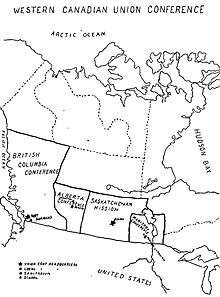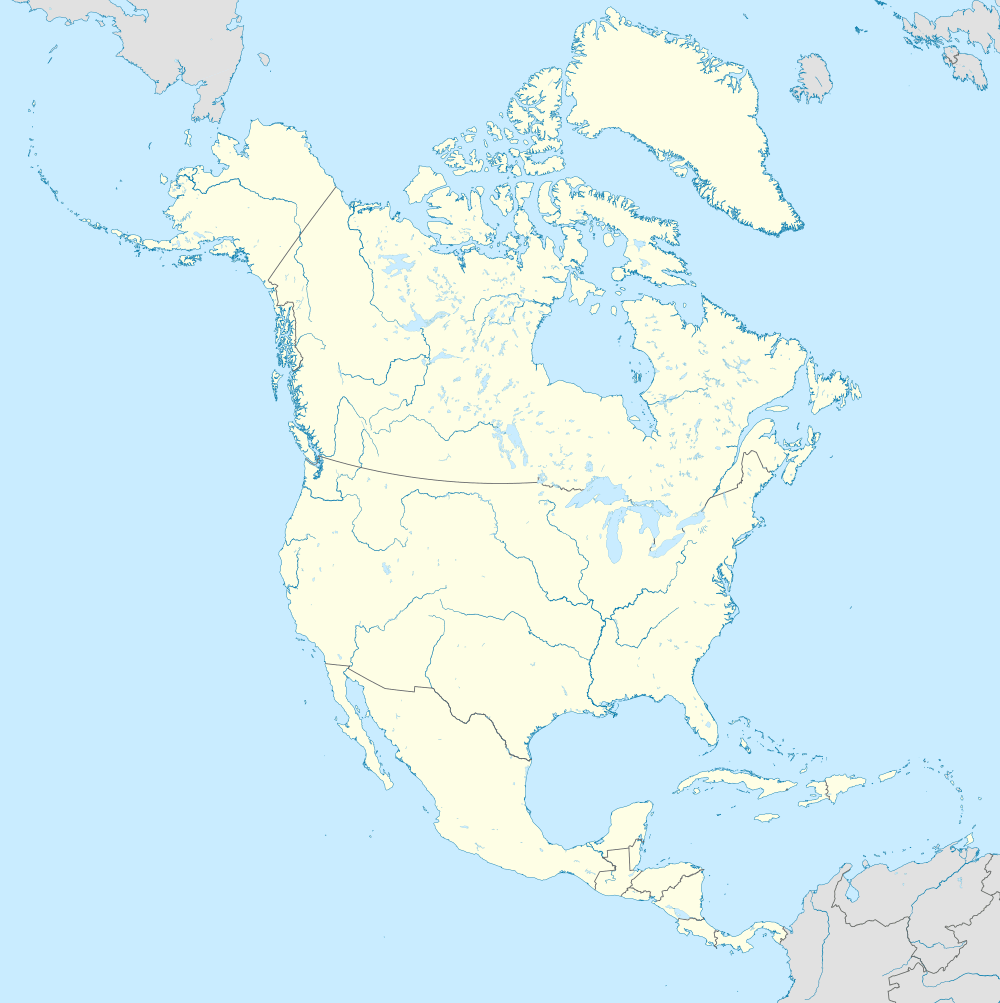History of Canadian University College
| Part of a series on |
| Seventh-day Adventist Church |
|---|
 |
|
Adventism Seventh-day Adventist portal |
Canadian University College is an independent publicly funded university located in Lacombe.[1] It is sponsored by the Seventh-day Adventist Church in Canada and is affiliated with the Association of Theological Schools.[2] It is a part of the Seventh-day Adventist education system, the world's second largest Christian school system.[3][4][5] [6]
The school's official mission statement is to educate learners to think with discernment, to believe with insight and commitment and to act with confidence, compassion, and competence. The college places emphasis on service in local and global communities.[7][8] The history of the college begins in the pioneer days of Alberta.
Pioneer Adventists in Alberta
Adventists first came to Alberta in 1895. They were colporteurs Thomas Astleford and George W. Sowler. Sowler was the field agent for Manitoba and the Northwest, which included Alberta.[9] Astleford and Sowler both sold "Bible Readings".[10] Astleford left Winnipeg and went to Edmonton. Sowler stopped off at Calgary and started work there. Sowler sold about two hundred copies of Bible Readings in Calgary. He also sold books to the ranchers from Calgary to Fort Macleod from the Bow River to the foothills. He worked in Edmonton and Fort Saskatchewan and the mountain towns as far as Revelstoke. Eastward, he worked along the main line of the Canadian Pacific Railway to Port Arthur.[11]
Thomas Astleford began in the Edmonton. He then sold books in the towns along the railroad to the south. His work led to the first converts in the province; Gustave Litke of Leduc and Dr. Menzel and his family, of Stony Plain. Litke shared his new faith with his German friends. In response to their request, H. J. Dirksen was sent from Manitoba. Dirksen led in the organizing of a church at Leduc on May 14, 1898, the first SDA church in the Northwest Territories.[12]
Up until 1903, the work of the Adventist church in Alberta was administered as part of the Manitoba Mission. Beginning in 1901, the Adventist Church reorganized itself to include union conferences. These new units of administration took over from the General Conference the management of local conferences in their region. The Northern Union Conference, established in 1902, managed the work of the Adventist church in Minnesota, South Dakota, North Dakota, Manitoba, Saskatchewan and Alberta.[13] In 1906, the Alberta Mission was organized into the Alberta Conference. A year later, the Western Canadian Union Conference was formed. It comprised the conferences of British Columbia, Alberta, and Manitoba and the Saskatchewan Mission.[14] (See the map)

The newly organized Alberta Conference consisted of about 180 members.[15] At the conference's first meeting, delegates took two actions regarding education. They voted to conduct a three months Canvassers' School. Second, they voted "to build up the church school work in the Conference as fast as possible." Veteran educator, Percy T. Magan, helped with the proceedings. He represented the General Conference.[16]
The Leduc School
Canadian University College traces its roots to Alberta Academy,[17] the first Seventh-day Adventist secondary school in Alberta. It began operations in January 1907 in Leduc. That first year, the school located in a rented building in town. The conference vote to conduct a three-month convasser's school had become a reality.[18]
They held their first chapel exercise, at nine a. m. Friday, January fourth. Nine students were present. In the next three weeks the number had increased to seventeen. Student nationalities reveal the cultural diversity of pioneer life in Alberta: English, Scotch, French, Swede, German, Canadian and mixtures from the States.[18]
Subjects taught included Bible, grammar, geography, physiology, arithmetic, reading and "Great Controversy". They planned to study other books as soon as it was determined which books would be sold in the Alberta Conference in the upcoming sales season. This illustrates the "Canvassers" nature of the curriculum. But, the Alberta Conference leadership had a broader vision for this school. Alberta Conference president, and principal of the school, C. A. Burman states, "a seed has been sown which will ripen into a well equipped intermediate school in due season." [18]
An elementary church school started in that same month of January in the same rented building with Effie Russell Olson as teacher.[18]
Within a year, the Alberta conference had purchased a farm of 160 acres three miles west of Leduc. They erected temporary buildings on the farm so the school, Alberta Industrial Academy,[17] could operate there in the next school year. A farm school better suited their educational ideals. Students could do work on the farm and be free from distracting influences of town life. The farm came with 100 acres of cultivated timothy grass, considered a valuable crop. President Burman and his wife lived on the farm and had charge of the school during this early formative period.[19] There were 36 students and three teachers.[20]
Forty-nine students enrolled for the 1908–1909 school year; most of them "mature young men". The weather that winter was severe. "For several nights the thermometer registered 50° to 60° below zero," the boys' dean, Joseph L. Stansbury, writes, "and we are not very well protected from cold. Some of the coldest nights it registered as low as 20° below zero in our sleeping-rooms. Two families are living in tents on the school farm, that they may have the advantages of the school. In spite of all this exposure and the bitter cold, we are all enjoying good health. Nothing more serious has resulted than a few frosted ears, noses, fingers, and toes. We are confident that students who cheerfully endure these disagreeable features, and do not allow our meager and inadequate accommodations to hinder or discourage them in their educational work, are gaining an experience that will be a very essential qualification for missionary work in foreign countries, where there are so many obstacles to be overcome..." [21]
Relocating to Lacombe
In 1909, the Lacombe site for the College was chosen.
Canadian Junior College
In 1919, the school became a junior college.
Canadian Union College
In 1947, it began its first four-year program in theology and adopted the name Canadian Union College.[22]
Canadian University College
In 1997, CUC's name was changed to Canadian University College.[2] Three years earlier, in 1994, the board of trustees for the college decided to change the name. They gave two reasons for doing so: Adventist Canadian headquarters had changed their name from the Canadian Union Conference to the Seventh-day Adventist Church in Canada. Outside of Adventist circles, people usually associated the term 'union' with 'organized labour'. The second reason was that the word 'college' did not accurately reflect the school's three- and four-year degree-granting status. In Canada, the word 'college' had become associated with two-year under-graduate community and vocational institutions. A name change committee was established. This committee appealed to the college's constituency, the Seventh-day Adventist membership in Canada, to suggest possible names.[23]
See also
External links
- Official website
- Rusk, M. The Hilltop Story. Canadian Campus, Spring 2007. pp. 6,7. Accessed 03-19-2011.
References
- ↑ Alberta Advanced Education. Retrieved 2011-09-02 Archived 2011-08-26 at the Wayback Machine.
- 1 2 History. Canadian University College. Retrieved 2009-08-03
- ↑ http://www.csmonitor.com/Commentary/Opinion/2010/1115/For-real-education-reform-take-a-cue-from-the-Adventists"the second largest Christian school system in the world has been steadily outperforming the national average – across all demographics."
- ↑ "Archived copy". Archived from the original on 2015-03-23. Retrieved 2015-04-10.
- ↑ "Department of Education, Seventh-day Adventist Church". Retrieved 2010-06-18.
- ↑ Rogers, Wendi; Kellner, Mark A. (April 1, 2003). "World Church: A Closer Look at Higher Education". Adventist News Network. Archived from the original on July 24, 2011. Retrieved 2010-06-19.
- ↑ Industry Canada. Canadian University College. Accessed 03-16-2011
- ↑ About Canadian University College. Canadian University College. Retrieved 2009-08-03
- ↑ Review and Herald, August 10, p. 14
- ↑ Bible Readings for the Home Circle 1888
- ↑ Western Canadian Tidings. Pioneer Colporteurs in Western Canada. Vol. 8 Calgary, Alberta, December 4, 1918 No. 23 p. 5
- ↑ Sudds, D. R. Colporteurs Were First in Alberta. Canadian Union Messenger, October 19, 1966, p. 11
- ↑ Yearbook of the Seventh-day Adventist Denomination, 1907, p. 47
- ↑ Yearbook of the Seventh-day Adventist Denomination, 1908, p. 88
- ↑ Statistical Report of Seventh-day Adventist Conferences, Missions, and Institutions For the Year Ending December 31, 1906, p. 2
- ↑ Northern Union Reaper, August 14, 1906, p. 5
- 1 2 The only evidence for this name, Alberta Academy, is in the school's first mention in the SDA church's 1907 statistical report. Statistical Report of Seventh-day AdventistConferences, Missions, and Institutions For the Year Ending December 31, 1907, p. 12 G. A. Irwin reported that President Burman "said that there had been received in cash and pledges for the Alberta Industrial Academy, over $4,000, and that the plan is to conduct a school the coming winter on the school farm in the buildings already erected on the ground." Irwin, G. A. A New Union Conference. Review and Herald, November 14, 1907, p. 20
- 1 2 3 4 Burman, C. A., "Canvassers' School" (PDF), Northern Union Reaper, January 29, 1907, p. 2
- ↑ Irwin, G. A. A New Union Conference. Review and Herald, November 14, 1907, p. 20
- ↑ Statistical Report of Seventh-day AdventistConferences, Missions, and Institutions For the Year Ending December 31, 1907, p. 12
- ↑ STANSBURY, J. L. Alberta Industrial Academy. Review and Herald, March 4, 1909, p. 28
- ↑ "Archived copy". Archived from the original on 2011-06-07. Retrieved 2012-07-27. The Encyclopedia of Music in Canada
- ↑ Canadian Union Messenger, March, 1994, p. 10
| Wikimedia Commons has media related to History of Canadian University College. |
Coordinates: 52°29′17″N 113°44′19″W / 52.4881°N 113.7385°W
